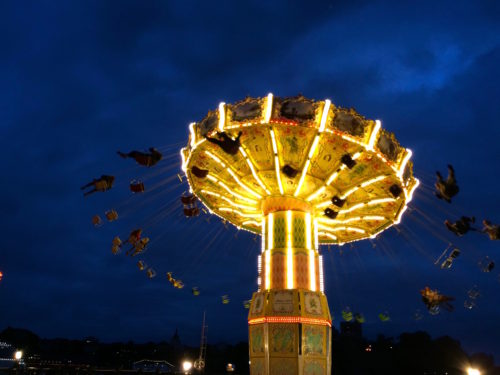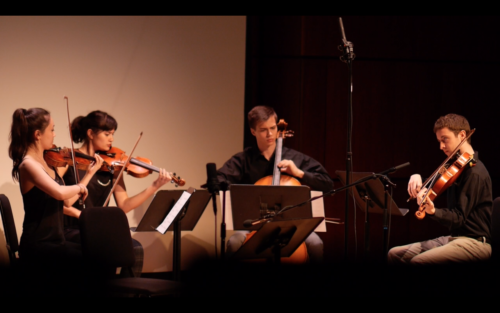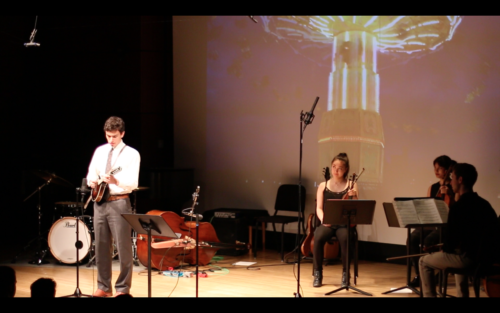
During the summer in Stockholm, the sun sets just before midnight. Evenings outlast after-dinner conversations as the light keeps people in the streets long after shops have closed and children have been put to bed. One night this past June, Noah Fishman ‘16 found himself alone at a local amusement park. He had arrived in Stockholm only days before to conduct research for his music thesis. Over the next three weeks, he planned to travel throughout the country to study traditional music and dance, attending workshops and festivals in locations ranging from Rättvik, a picturesque town in Dalarna, the nation’s “cultural heartland,” to Föllinge, a rural village in the Northwest.
A foreigner without any connections, he was unsure how best to pass his time. The city was still too awake to justify sleep, so he thought he might as well explore the park, trying out each ride by himself. Eager to hold on to as many sights and sounds as he could capture, he recorded every attraction in time lapse video on his iPhone. His favorite was a carousel, which glowed yellow against the dimming sky.
Later, this would become the poster image for Fishman’s thesis recital, “Lyssna,” an ambitious, complex, and heartfelt tribute to the summer’s exploration. The title came from a dance workshop he’d attended in Föllinge towards the end of his trip. He was learning a traditional folk dance in which paired dancers turn, both with their partners and as part of a larger circular formation, around a single fiddler at the center of the floor. Unlike other fiddling traditions, he noted, Scandinavian fiddling places a specific emphasis on the relationship between musical rhythm and the rhythms of physical movement. “The fiddler is free to take whatever liberties he wants with the time, and everyone sort of responds as a single organism,” he told me.
During a break in the lesson, Fishman asked the workshop’s leader to describe how momentum is treated on the dance floor. In response, the instructor explained that the word lyssna, Swedish for listen, also denotes a certain physical awareness of another person, an attention to the movement of their body alongside one’s own. For Fishman, the term perfectly captured the dynamic conversation between music and movement, between musical time and physical space, which had first drawn him to the Swedish folk tradition. “I thought it was a really beautiful concept for a project,” he said.
I attended the recital without any formal musical background to guide my judgment. “There’s going to be a lot going on—music, talking, multimedia,” a friend assured me when I expressed anxieties about my own limited knowledge. “It’s not like you’ll be sitting through a symphony.” In fact, the performance was unlike any concert I’d ever been to. Held in Taplin Auditorium, it drew a substantial crowd, equally comprised of students (fellow musicians, friends from Terrace) and older attendees, whom I took to be family members and mentors. There was a flurry of clapping as Fishman stepped onstage. “Thanks for coming out, everyone,” he offered with a toothed grin. “Is it raining yet? Thanks for coming out in the rain.” He paused. “Or before the rain.”
At once adventurous and earnest, the recital alternated between original compositions performed by a string quartet—Emma Powell ‘17 on first violin, Samantha Cody ‘17 on second violin, Sam Matzner ‘17 on viola, and Calvin VanZytveld ‘19 on cello—and semi-improvisational solo pieces by Fishman on an impressive range of instruments: electric bass, double bass, piano, acoustic guitar, and mandolin. Fishman interspersed the movements with video footage from his time abroad, piloting us through airports and train stations and past lakes and mountains. All video, he explained, had been filmed on his iPhone; he’d captured many of the outdoor shots through the windows of trains. “I sort of obsessively take videos and recordings,” he told me, scrolling through an extensive library of voice memos. “I record everything I hear. Like I’ll go back and find a video of myself walking across campus and nothing’s happening, but you can hear my feet.”

In both his research and compositional work, Fishman strove to prioritize subjective experience. “I really tried to resist taking an academic approach,” he told me. He recalls researching kulning, or Swedish cattle calling, in preparation for his trip. “I’m reading this book, and the musicologists are talking about what frequency you find and the different formants of the vocal tone—and I’m like, man, that doesn’t tell me anything about how it sounds or makes you feel or what it’s like to be there,” he said. “So I tried to resist every sort of objectivity, and put my physical and emotional experience before any academic one.”
Indeed, the performance was viscerally compelling. Immersed in evolving harmonies and asymmetrical rhythms, I found myself transported to a space outside the predictable and rigid schedules of junior spring, of deadlines and word counts, into a rustic, sunlit world where patterns existed to be deconstructed and reformed.
One of the most goosebumps-inducing moments occurred when, during his solo on double bass, Fishman was spontaneously moved to sing. He was performing a kulning fiddle tune called Blägeten, or “The Blue Goat,” which he’d first learned a harmonized version of in Sweden. He began the piece traditionally, approaching it with the arca, or bow, and later transitioning into a plucked, partially improvisational jazz interpretation. As he moved back into the melody to close, however, the counter melody was still swirling in his head. “I thought, ‘how nice would it be if I just sang the counter-melody to it,’” he remembers. “So that came out.”
For the quartet members, as well, the show demanded as much emotional investment as it did technical skill. For much of the rehearsal process, Cody noted, she had been too focused on simply learning the music to fully experience its psychological impact. Classically trained, both she and Powell were largely unfamiliar with the folk tradition from which Fishman was drawing. They particularly struggled with the second movement, a deconstruction of a polska, which relied heavily on plucking and demanded a formidable amount of coordination between musicians. “Basically, he wrote a melody but each note was given to a different person,” Powell explained. “Trying to pass off between so many people got so confusing.” They were still working on the movement the day of the rehearsal.
Once they had solidly mastered their parts, however, playing became a radically different experience. For both violinists, this transformation didn’t take place until the performance itself. “I didn’t know how emotionally up and down the whole thing was,” Powell told me. “Because the first part is really happy and really great, and then when you get to the angstier parts”—she laughs—“I guess it just got to me a lot. At one point I closed my eyes and forgot where I was on the page.” Cody agreed. “It got really intense,” she reflected.

As a finale, Fishman attempted something unlike anything he had ever tried before. The unconventional piece began with Fishman alone, seated at the piano. After a few moments, one of Fishman’s teachers emerged from the audience and took over the piano as Fishman moved to the double bass. Several phrases later, another audience member stepped onstage and, without any break in rhythm, adopted Fishman’s place on bass. The cycle continued as Fishman revisited, in turn, every instrument he’d played, creating a “looping” effect that wove together the multiplicity of sounds that had characterized the performance so far.
When he and his advisor, Jason Treuting, had first developed the idea, Fishman had been resistant to it. “I didn’t want to do it. It was a cool idea, and I really didn’t want to do it, because I was afraid I didn’t have enough time to pull it off,” he admitted. In addition, he was anxious the focus on his own playing would appear overly self-indulgent. Yet that night, he emailed a handful of friends and teachers, and before long their vision was on its way to realization.
Guitarist Michael Delgado ’17 described the process as “organic,” and there was a certain naturalness to the way the musicians took over for one another, distinct bodies attuned to the same rhythms. The result was a mesmerizing combination of musical textures, but it was also a triumphant testament to the power of communication and kinship between players—the way that rhythm isn’t merely an artistic object but also a force that draws people together, both demanding and enabling communication in a way that words sometimes can’t.